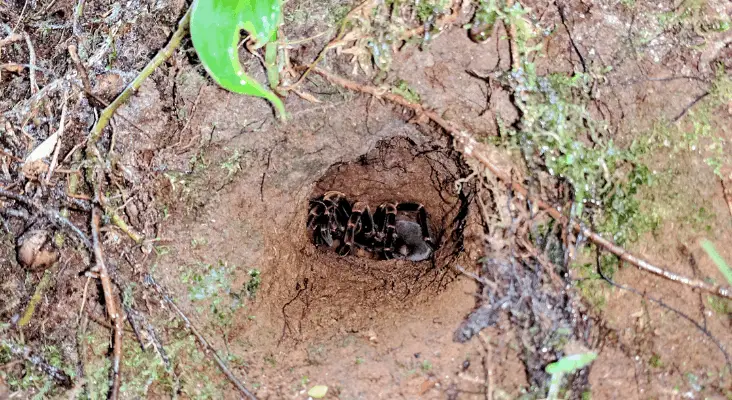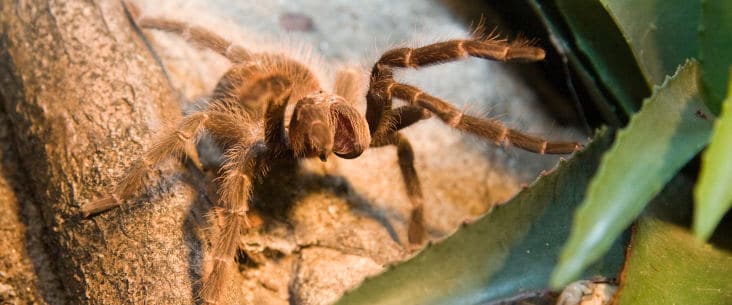Recently I’ve got a really intriguing question: Do tarantulas sleep? As much as the tarantula is part of our culture and regularly kept as pets, surprisingly little is known about the sleeping behaviour of this hairy big spider. Actually, there is not much known about sleep in spiders and insects in general. In this article, we discuss what is known about the sleep-state of tarantulas.
Tarantulas have sleep-like states and cycles, but they don’t sleep the same way as most mammals and other animals do. In their sleep state, they reduce their activity level and lowering their metabolic rate with the main purpose to conserve energy. Within this state, tarantulas can live long periods without any food source.
We don’t know much about the sleeping behaviour of tarantulas, and there is not done much research on this specific topic. So, what do we know about the sleep-like patterns of tarantulas?
What is sleep exactly?
As of today, there are no studies done to research the sleep behaviour of spiders or of tarantulas in particular. It is quite difficult to do so because the nervous system and brain size and composition are rather different from that of mammals and us humans.
The criteria of sleep can be defined as follow:
- A resting-state with reduced activity;
- Reduced responsiveness to external stimuli;
- Full reversibility of the resting state.
Sleep in mammals, just like us, function as a time to repair and restore different parts in our bodies like muscles, brains and many cells. We use it to regain energy and give our brains some rest of thinking and making memories. With tarantulas, it is not known if they get is a similar state. However, we know that they have certain cycles of activity and rest.

The tarantula sleep-state
In general, tarantulas tend to be more active during the night, where they leave their burrows to catch prey and find a potential mate. During the day, they lie dormant, hidden inside their burrows. However, before the end of the day, you’ll see them regularly sitting in the opening of their burrow.
When they are sitting in their burrows, they will lower their metabolic rate, which conserves energy. This surviving mechanism is beneficial. Most tarantulas don’t actively hunt on prey, and they depend on prey that comes to them. This means they need to wait until the next meal comes along. And that wait can sometimes be a very long one.
However, when they are in this resting state, they can quickly come out and be fully active in catching prey walking by or attacking any danger close by.
When you are a tarantula keeper for a while, you probably experienced it a couple of times. When your tarantula is “resting”, it won’t react to the first stimuli. After a second or third nudge, it suddenly comes alive and immediately flick hairs or lunge towards your hand. It is like they have been startled out of “sleep”. So, we can conclude that they have some sort of sleep state.
Do tarantulas need a day and night cycle?
Why are tarantulas active at night. The main three reasons are that:
- Animals that predate tarantulas are mostly active during the day.
- Their food source comes above ground during the night
- At night is a better climate for many tarantula species.
However, when you keep them as a pet, they won’t have those challenges. They don’t have any enemies. You will probably supply food on a (semi-)regular basis, and the climate is mostly stable.
Still, light is a strong indicator for animals to sustain those diurnal cycles, and it is believed that it has many welfare benefits. For example, it can be very stressful for a tarantula when they don’t have any day and night cycle. Also, the resting state of tarantulas is very beneficial for their welfare and long-term health.

Do tarantulas hibernate?
Tarantulas that lives in colder climates appears to have a sort of hibernation period during the cooler months. They will plug the entrance of their burrow with dirt, plant material and webbing, and stay below ground for a long time. They keep inactive, draw their legs into their body and won’t eat during hibernation.
This is only possible because they drop their metabolic rate to conserve energy. However, there is not much known about what they do during this hibernation process.
However, the ability to deactivate the body and parts of the brain for a long period of time may very well suggest that they might be able to do it for shorter periods in their everyday cycle, which could be seen as a form of sleep or rest.
Other bugs you can keep as a pet
Although cockroaches are amazing pets, there are many other bugs that make great pets too. Check out the bugs below, maybe you find them even more interesting to keep.
– Praying mantises
– Millipedes
– Beetles
– Ant colony
– Tarantulas
Share this page!



